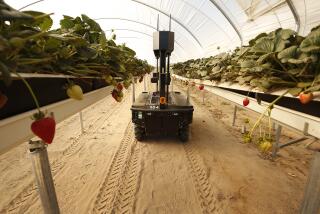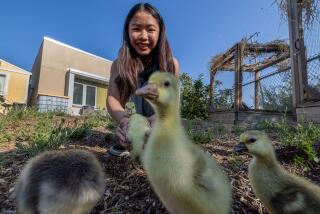Pierce College Farm Is an Asset to Community
* Dr. M. Stephen Sheldon’s letter to the editor of July 24 “Pierce College: Bigger Isn’t Necessarily Better,” states, “There is no such thing as the Pierce College Farm.” This statement is outdated, shortsighted and does a disservice to the college.
Dr. Sheldon correctly states that there are several agricultural programs in horticulture and animal science. He neglects to mention that the enrollment in these programs is above the state average for class size. He states that the students enrolled in agricultural programs represent 4% of the student population while “taking up more than 50% of the land.”
Are we to translate this concept into square footage of classroom utilization and eliminate those programs that use relatively more space? At Pierce College, the quality and need for an instructional program are based neither on square footage nor on acreage.
The value of the Pierce College Farm goes far beyond enrollment in the instructional program. The farm is a unique asset to the college and to the community.
On July 4, more than 150 volunteers from the community and from the college--including students, faculty, staff and administrators--worked together to put on a “farm walk.” The wonderment of a 3-year-old toddler looking a Suffolk ewe in the eye, or a teen-ager petting a horse for the first time, or families walking together through the pasture taking in the aroma of freshly turned earth would convince anyone that the farm is an asset that needs to be fostered rather than disparaged.
At the southwest corner of the farm is a canyon that serves as a nature preserve for students in the biological programs as well as interested community members. Red-winged black birds, owls and egrets are among the birds sighted there as well as the occasional monarch butterfly. Canada geese visit each year on their annual migration. Where else in the Los Angeles Basin can one find comparable agricultural and natural treasures?
The Pierce College acreage forms an integral part of its master plan. Nothing in the plan includes “doing away with” the agricultural programs, “dismissing the agricultural faculty” or getting rid of the small herds of cattle, swine, sheep and horses.
At a time when Pierce College is making every effort to reverse enrollment declines, bring expenditures under control, implement improvement of facilities, work with the residential and business communities, maintain a balanced and quality instructional program and develop a master plan that will make Pierce College a showcase for the greater Los Angeles area and the state, we welcome positive, constructive input from individuals.
Naysayers contribute little to the successful future of Pierce College.
MARY E. LEE
President
Los Angeles Pierce College
Woodland Hills
* While certain points of Sheldon’s cynical commentary about the Pierce College Farm may ring true, I feel that the larger issue at hand was ignored.
I work at the farm with 10 urban high school students as part of the city of Los Angeles’ Summer Youth in the Environment Program. The students are involved in restoring the horticulture unit and growing grounds of the farm, in addition to many other projects.
I must say that it is obvious that the farm has fallen into an unfortunate state of neglect, yet it still has the potential to give urban students the opportunity to learn firsthand about the land they live on.
For most of these students, this is their first experience being on a farm, and it opened their eyes to a whole new world. Many of these young adults are now interested in studying horticulture and animal studies at Pierce College, an option they would perhaps never have known was open to them had it not been for the farm.
Since being on the farm, I have met many citizens and students who are active in trying to save the Pierce College Farm from being developed for commercial ventures. Perhaps positive changes would occur if their suggestions and ideas were listened to and taken seriously.
The farm remains a valuable teaching tool and is one of the few places in Los Angeles County where people can learn about agriculture--hands-on. Agriculture is still California’s largest industry.
RONNA FRUMKIN
Los Angeles






